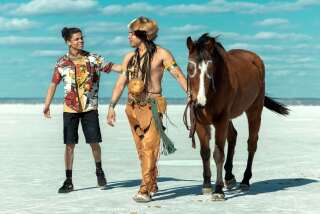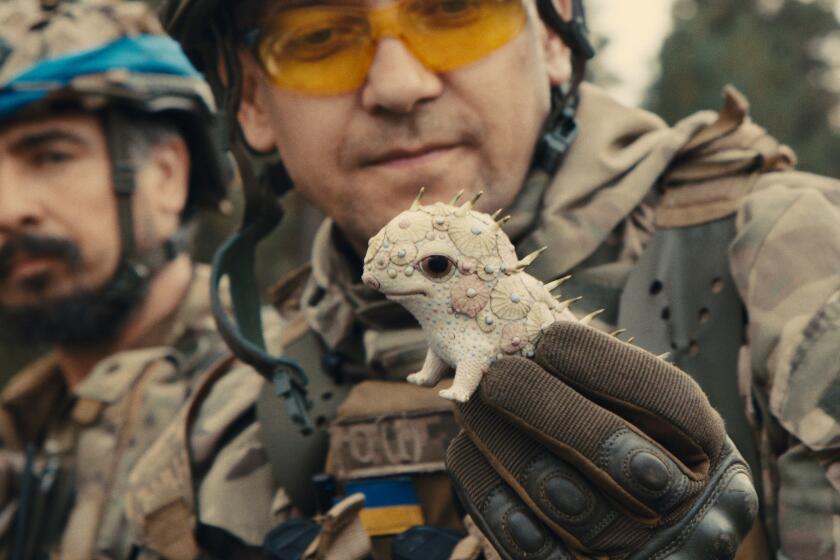Their turf, their tongue
- Share via
There was a point during production of “Ten Canoes,” the first feature made entirely in an Australian indigenous language and based on traditional stories, when writer-director Rolf de Heer asked himself, “What am I doing here?”
Made in collaboration with and featuring numerous members of the Ramingining Aboriginal community in Arnhem Land in northern Australia, the lighthearted comedy is set years before the arrival of whites, during tribal times of the Yolngu.
Ten men, led by Minygululu, go into the forest to harvest bark to make canoes so they can gather goose eggs in the swamp. Minygululu learns on the trip that his youngest brother, Dayindi, has feelings for Minygululu’s third and youngest wife. Because tribal law would be broken if the two young people become lovers, Minygululu decides to teach his brother a lesson by telling him an ancient tale of rivalry and respect.
The film, which opens Friday at the Nuart in West Los Angeles, swept last year’s Australian Film Institute Awards and won a special jury prize at the 2006 Cannes Film Festival.
De Heer frequently had to get into the murky Arfura Swamp to direct. “There were always crocodile spotters with guns in trees,” he says over the phone from his home in Adelaide. “There were leeches and mosquitoes. I remember [one day] being up to my waist in the water for six hours already. The mosquitoes had been getting me from the waist up and the leeches had been getting me from the waist down. Then one of the crocodile spotters cried out, ‘There’s a big one coming.’ And I thought, ‘My God, get me out of here!’ ”
De Heer was asked to make a film with the Ramingining community by noted Aboriginal actor David Gulpilil (“Walkabout,” “Crocodile Dundee”), who provides the playful English narration in “Ten Canoes.” His son Jamie plays Dayindi.
The project had its genesis in late 2000, when De Heer cast Gulpilil in his film “The Tracker.” Upon meeting him, the filmmaker experienced culture shock. “I could barely understand his English and I thought, ‘I don’t know anything about this man culturally. I don’t know how to direct him.’ ” So Gulpilil invited De Heer to visit him on his home turf.
“I went up there for a week and even then it was clear that David had ideas for a lot of films, and he wanted them all shot up there,” De Heer recounts. “The fundamental thing for him was, ‘Come up here and make a film with me and my people on my land.’ He had a cowboy movie, he had a massacre film and he had a cattle drive film in mind.”
Gulpilil’s pleas continued after production ended on “The Tracker.” Eventually, says De Heer, “it clicked in my head -- not the idea for the film, but how to make the film up there: You would have David as the co-director, because working with indigenous people is often quite difficult because of communication and serious alcohol problems. David is no different, but David’s community is a dry community, so he [would] be easy to work with.”
De Heer says he realized that if the project were going to succeed, the Aboriginal community would have to feel real ownership over the film and over the filmmaking process, “because filmmaking is almost the antithesis of their culture. Filmmaking is very hierarchical and schedule-driven, and their culture is very consensus-based, and time has a different meaning. I understood very quickly the process had to be set with their culture. There was no way they would be able to sustain the effort unless they felt ownership of the film and the process.”
But although Gulpilil does provide the movie’s narration, he pulled out of the shooting early on for what De Heer describes as “complicated” reasons involving his community and “all sorts of things, his domestic situation. Eventually he left the community because he was afraid he was going to get speared.” He now lives in the nearby city of Darwin.
Peter Djigirr, a member of the Arafura Swamp people known as the “crocodile man,” ended up being the co-director. “From the beginning, he showed himself to have a sort of practical sense of things and an understanding that went way beyond everybody else quickly,” De Heer says.
More to Read
Only good movies
Get the Indie Focus newsletter, Mark Olsen's weekly guide to the world of cinema.
You may occasionally receive promotional content from the Los Angeles Times.











